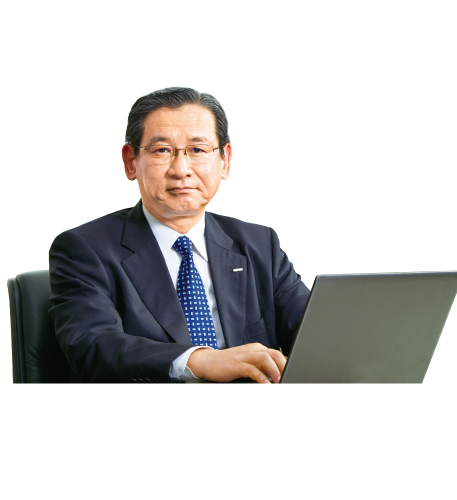- Value Creation Story
(PDF) - CEO
Commitment - Growth
Strategies - Financial Strategy
- Latest
Creative Report - External Directors'
Messages

Aggressive investment for growth backed by a strengthened financial foundation in response to an evolving market.
Kenkichi Nomura
Director,
Executive Corporate Officer and Chief Financial Officer (CFO)
Medium-term growth strategy progress
Changes in the business environment
Capcom is making efforts to expand our users globally. In other words, we are working on increasing annual unit sales of game software. Due to the digital shift that has taken place in recent years, sales channels are diversifying. Our target sales areas have now expanded to more than 200 countries and regions, and annual sales of game software exceeded 30 million units in the fiscal year ended March 2021.
This is due to the fact that as digitalization progresses, game content is spreading throughout the world beyond the framework of traditional distribution channels, which means there has been a major change in user purchasing behavior. On top of that, the multiple platform strategy Capcom has been pursuing for some time has been effective in responding to the diversification of devices, such as PCs and smartphones that can now be used in addition to home video game consoles.
Our user base has expanded due to the promotion of a digital strategy that includes responding to the expansion of distribution channels, such as PCs and subscriptions, and the aggregation and analysis of purchasing trends as explained in the messages from the CEO and COO. However, in terms of finance, our revenue and financial structures have changed significantly and are still in the process of changing.
Changes to the revenue structure in the last five years
First, I will explain the financial index Capcom prioritized these last five years. The table on the left shows a comparison between the fiscal year ended March 2016 and the fiscal year ended March 2021. The increase in operating income is quite impressive compared to the increase in net sales. This can be attributed to the expansion of our global user base (i.e., increase in unit sales), but also from a financial perspective, we are making progress in cost management with a lower cost-of-sales ratio and lower SG&A expenses ratio.
This is due to the following factors: (1) by developing and providing content that meets users’ expectations in the consumer game division, we have achieved net sales and unit sales numbers that exceed what we had planned, and we have posted performance results that exceed our assumed ROI, and (2) due to the evolution of development methods and technology, we have become more efficient, which serves the function of absorbing increases in cost. In the last few years in particular, progress and cost management methods have evolved in development, along with a system that allows us to identify the problems and issues that arise in content creation and address them as soon as possible.
In addition, our practice of steadily hiring new employees each year and developing their talent as soon as possible is absorbing the increased development costs that accompany the evolution of gaming devices. As a result of these efforts, our work in progress for game software balance has remained at almost the same level as it was five years ago. This has contributed to improved operating cash flow, which is an indication of our earning power.
Changes have also been occurring in SG&A expenses resulting from the progress of our digital strategy. We are in the process of evolving from traditional sales promotion methods to using digital media to disseminate information. Promoting digitalization is helping us achieve lowered costs in terms of business and administration as well.
At Capcom, we are also aiming to lengthen the sales life of each title, and we are expanding our user base while maintaining the freshness of titles by releasing updates and holding events, even after a title has been released. This leads to a faster recovery of development costs post-release, and catalog titles released prior to the last year in particular show extremely high profitability. Expanded sales of catalog titles is one of the main factors behind the improvement in ROI of titles and the increase in profit margins.
Investment in future growth strategies rooted in a strengthened financial foundation
I think everyone understands that the aforementioned strengthening of our digital strategy has brought about significant changes in our financial and profit structure, and that we have moved up to the next stage.
As a result, our ROE and ROA, which we focus on as indicators of improved capital efficiency, have made significant strides.
If you compare the same figures for the fiscal year ended March 2021 with those in our industry, you will see that we are positioned at the top. Looking at this, I believe that our strong performance this fiscal year was not only the result of being bolstered by the demand created from people staying at home to prevent the further spread of COVID-19, but rather the main factor was the steady progress we have made in our growth strategy, which we have been advancing for some time now, and that our medium-term management goal of stable profit growth each year can be achieved next fiscal year and beyond.
Capcom’s cash and deposits have been continuously increasing in recent years due to the increasing operating profits we are experiencing every year. Our immediate goal is to reach a cash and deposits balance of 100 billion yen. This is based on our aim to secure approximately three times the amount of our annual development investment. As the nature of our business is creating hits, we are constantly exposed to various changes and risks. Our desire to secure three years of development funds stems from the risk of being unable to immediately adapt to these changes. At the end of fiscal year 2020, our cash and deposits balance was 71.2 billion yen. Though, taking into consideration the amount of accounts receivable from new title sales released immediately prior to the end of the fiscal year, effective net cash was 87.0 billion yen, thus we are on track to reach a balance of 100 billion yen in cash and deposits.
Our basic stance of prioritizing cash, strengthening earning power, and enhancing capital efficiency will remain unchanged, but we will make swift and effective strategic investments based on our medium-to-long term strategy while we anticipate changes in the business environment, such as the Digital Contents business, where we expect to see further significant changes in the future.
I. R&D Investment in cutting-edge technology
There is no question that the environment surrounding games will be changing increasingly. In addition to the evolving communications environment, we will need to incorporate the latest various technologies, including technologies peripheral to games, in our research and development to a greater degree than before. Bringing our research and development related to these new technologies to the next level will become an important management issue in the future, and we will have to address it proactively. In order to so, we will have to secure even more new human resources than we have in the past and aggressively invest in the research and development of new technologies.
II. Investment in business infrastructure
We will also have to respond to changes in our business structure. In order to achieve 100 million units in annual sales in the near future, we have to analyze how game users around the world gather information about games and make their purchasing decisions. In addition, we plan to accelerate investment in business infrastructure, which includes strengthening our approach to unauthorized access from external sources, such as the incident we experienced in November 2020 that was a source of complications and concern for our stakeholders.
III. Investment in securing and developing human resources
R&D and content production are ultimately investments in human resources. In order to further expand our sales globally, securing and develop diverse human resources is essential.
We recognize that diversity is an important issue in promoting our medium-to-long-term strategy for the future, and as such we will continue to focus on hiring women as well as foreign nationals.
From the perspective of developing human resources, we have begun promoting management committee level issue awareness, to give highly motivated human resources, regardless of whether they are longtime or younger employees, the opportunity to proactively experience management issues, share new management issues in the future, and from among them, strengthen new proposals and our ability to respond to issues.
IV. Addressing ESG & SDGs
I would like as many people as possible around the world to enjoy our game content, and it is from that perspective as well that we will continue to be proactive in addressing ESG and SDGs. When we first launched our policy to expand and strengthen digital sales five years ago, we were also thinking about how digitalization would reduce the use of plastic and contribute to more effective usage of resources. Today, the way in which companies are addressing climate change is receiving a lot of attention, and we will continue to be aggressive in examining what Capcom can do as a company regarding this issue.
In addition, as one of our basic social contributions, we conduct a certain scale of philanthropic activities, and it is our intention to continue strengthening these activities into the future.
Approach to shareholder returns accompanying corporate growth
Our approach to shareholder returns remains the same. We will continue to strive for stable dividends with a basic policy of maintaining a consolidated dividend payout ratio of 30%. As of the fiscal year ended March 2021, we have achieved five consecutive years of increased dividends if you take the stock split into consideration, and we hope to achieve steadily increasing dividends by continuing to demonstrate stable growth performance. I recognize that acquiring treasury stock is one of the most important policies that contributes to return of profits to shareholders, so we will take the appropriate action as opportunities arise when we can determine that it will contribute to an increase in stock value, as we have done in the past. Meanwhile, we are currently reviewing specific ways in which we can use treasury stock.
According to our estimates, as of the fiscal year ended March 2021, the cost of capital (WACC) was 3.52%. We focus on ROE rather than ROIC because of Capcom’s high capital adequacy ratio and small amount of debt, and our ROE for the same period (22.6%) far surpasses this number. We will continue to achieve our medium-term goal of a stable increase in operating profits each year, which will help us maintain our high standards and meet the expectations of our shareholders.
CAPCOM INTEGRATED REPORT 2021
PDF (Complete version) (PDF:12.5MB/ 103 page)
PDF (by section)
Value Creation Story
(PDF: 6.2MB / 24 page)
- Create Financial and Non-Financial Value
- Corporate Philosophy
- History of Value Creation
- Major Intellectual Properties (IP)
- Effectively Leveraging IP
- World Leading Development Capabilities / Digital Strategy Performance
- ESG Highlights
- Value Creation Model
- Financial Highlights
- Business Segments Highlights
- Medium- to Long-Term Vision












